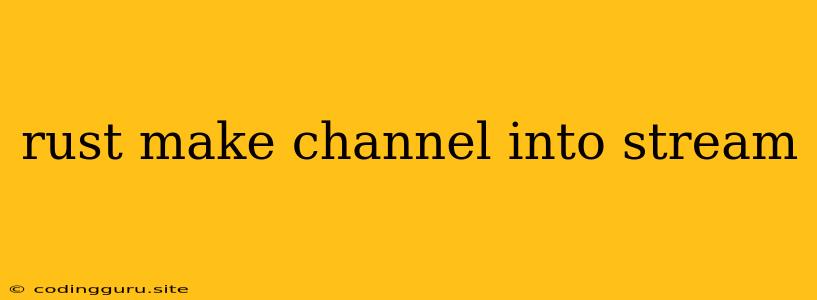Turning Rust Channels into Streams: A Smooth Transition
Rust's channels are a powerful mechanism for inter-thread communication, allowing you to send data between different parts of your program. However, working directly with channels can sometimes feel a bit cumbersome, especially when you're dealing with a stream of data. Enter the Stream, a versatile data structure in Rust that offers a more convenient way to handle continuous data flow.
But how do you bridge the gap between channels and streams? This article will guide you through the process of converting a Rust channel into a stream, empowering you to leverage the benefits of both worlds.
Why Transform Channels into Streams?
Before diving into the specifics, let's understand why converting channels into streams is often a desirable approach:
- Stream-Oriented Programming: The
Streamtrait in Rust provides a rich set of methods for working with sequences of data. This includes operations like filtering, mapping, reducing, and more. - Compositionality: Streams compose well with each other, enabling you to build complex data pipelines by chaining together different transformations. This promotes code readability and maintainability.
- Asynchronous Operations: Streams can work seamlessly with asynchronous operations, making them ideal for handling data from sources like network connections or file I/O.
The Fundamental Transformation
The core concept lies in using a tokio::stream::unfold function, which allows you to create a Stream from a custom function that produces data. This function takes a state and a closure. The closure is responsible for generating the next element in the stream, potentially updating the state in the process.
Here's a basic example:
use tokio::stream::unfold;
use tokio::sync::mpsc;
#[tokio::main]
async fn main() {
let (tx, mut rx) = mpsc::channel::(10); // Create a channel
tokio::spawn(async move {
for i in 0..10 {
tx.send(i).await.unwrap();
}
});
let stream = unfold(rx, |mut rx| async {
match rx.recv().await {
Ok(value) => Some((value, rx)),
Err(_) => None,
}
});
let mut values = stream.collect::>().await;
println!("{:?}", values); // Output: [0, 1, 2, 3, 4, 5, 6, 7, 8, 9]
}
In this example, we first establish a channel (tx, rx) to transmit integers. Then, we spawn a task that sends a sequence of numbers to the channel. Finally, we use unfold to create a stream from the channel receiver rx. The closure within unfold receives the receiver, waits for an element, and returns the element along with the updated receiver (essentially, itself) for the next iteration.
Beyond Simple Channels
The transformation isn't limited to simple channels. You can apply it to more complex scenarios:
- Asynchronous Streams: If your channel is receiving data from an asynchronous source, you can directly use the channel's
recvmethod in theunfoldclosure. - Error Handling: You can integrate error handling into the
unfoldclosure to gracefully handle potential errors during the receive operation. - Cancellation: You can combine
unfoldwith thetokio::stream::StreamExttrait to add functionality like cancellation to your stream.
Benefits of the Conversion
By transforming channels into streams, you gain several advantages:
- Stream-Based Processing: You can leverage the full power of Rust's
Streamtrait, including chaining multiple operations and processing data in a reactive fashion. - Code Clarity: Using streams often results in more concise and expressive code, making your data processing logic easier to understand.
- Flexibility: The ability to combine channels with streams allows you to choose the best approach for different situations.
Conclusion
Converting channels into streams in Rust is a powerful technique that opens up new possibilities for data processing. The use of tokio::stream::unfold provides a robust and efficient way to achieve this transformation. By leveraging the benefits of streams, you can create more streamlined, composable, and asynchronous data pipelines.
